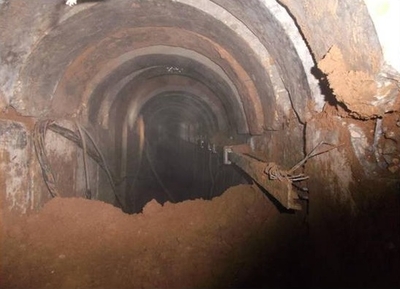|
|
|
|
Steven Emerson,
Executive Director
|
May 6, 2016
|
Israel's
Tunnel-Detection Success Poses Hard Choice for Hamas
by Yaakov Lappin
Special to IPT News
May 6, 2016
|
|
|
|
|
Share:  
|
  Be the
first of your friends to like this. Be the
first of your friends to like this.

In late March, we reported that pressure was building within the
Hamas-run Gaza Strip, which could lead to a new round of fighting with
Israel.
In recent days, violence out of Gaza has indeed escalated significantly,
and the trigger has been a succession of breakthroughs in the Israel
Defense Forces' (IDF) ability to detect cross-border assault tunnels that
threaten Israel's south.
On Thursday morning, the IDF announced that it had found a tunnel 30 meters (98 feet) underground that
reached into southern Israel, not far from where the IDF used new
breakthrough technology to locate another tunnel in April.
Realizing it is about to lose its most prized offensive weapon against
Israel – the ability to inject murder squads in Israeli territory though
tunnels – Hamas's military wing decided to do something it has not done in
almost two years. It began a succession of cross-border mortar attacks in the vicinity, with a view to
disrupting the detection work, and more importantly, to signal to Israel
that Hamas is willing to risk war over its tunnel program.
Hamas's attacks began on Tuesday with small arms fire and a mortar
attack on IDF unit near southern Gaza carrying out engineering tunnel
detection work. It escalated on Wednesday, as units came closer to locating
the tunnel, resulting in multiple mortar attacks, and Israeli retaliatory
tank and air strikes.
By Thursday morning, the IDF located its latest tunnel, sending home the
message to Hamas's military wing that the days in which it could dig
subterranean structures under the border into Israel are drawing to a
close.
Hamas persisted in mortar attacks, which at this stage appear to be
missing Israeli forces deliberately, sparking yet more tank and Air Force
replies by Israel.
"We view this technological, intelligence, and operational effort
as a success. We can say that this tunnel is a violation of our
sovereignty," a senior IDF source said on Thursday.
According to the source, Hamas's attempts to tell Israel to stop
destroying its tunnel program are in vain.
"We are determined to continue with these efforts, and understand
that we must focus in these areas," he added.
Looking ahead, two principal scenarios could unfold in the coming days
and weeks. The first possibility is that Hamas's military wing does not
back down from its so-called red line, and continues to back up its call
for Israel to cease tunnel-detection work with cross-border fire. In such a
scenario, Israel would be hard-pressed to contain a resumption of the
reality that existed in the south prior to the 2014 conflict with Hamas. A
resulting security escalation would rapidly grow in scope, and the IDF
would quickly have to implement plans to destroy the military wing's
offensive capabilities.
This development would result in a major new conflict, which could end
with only Hamas's political wing remaining intact, as well as the Islamist
regime's domestic police force.
Unlike previous rounds of fighting, Israel this time may be determined
to destroy Hamas's 20,000-strong military wing, including the 5,000-member
Nuhba elite force (which is trained to cross into Israel via the tunnels).
In essence, Hamas needs to choose between backing down from its stance
on Israel's tunnel detection, and watching its trump card blow away, or
risk the existence of its military wing.
Should it choose the latter, it would comply with the wishes of Hamas's
political wing, which is less eager to provoke a military confrontation
with Israel so soon after the 2014 war.
"Operation Protective Edge" was the most intensive conflict
ever experienced by Hamas.
The two-month war left a deep imprint on Hamas. It challenged Hamas to a
far greater extent than any previous military clash with Israel since Hamas
seized power in Gaza in 2007. It was exposed to the most sustained and
accurate Israeli firepower in its history, and lost more of its operatives
in battle than any previous time (although it had also never achieved this
level of capabilities before 2014). Hamas is still in the midst of
rebuilding its rocket arsenals, rebuilding tunnels, and constructing
drones, as well as assembling a naval terrorist intrusion unit. Gaza's long
suffering civilian population, under the grip of its Islamist jihadist
rulers, may not wish to stomach a new war so soon.
The fact that, until now, Hamas has not fired a single projectile or
bullet at Israel indicates that it understood that Israel is not prepared
to seek containment as a response to ongoing cross-border fire.
These factors could be enough to deter Hamas from continuing to escalate
the situation further.
The coming days will reveal what Hamas chooses. None of its options are
attractive. Ultimately, its choice is between fighting for its tunnels, and
risking its existence as an Islamist fighting force, complete with
brigades, battalions, and command and control capabilities, thousands of
rockets, and many thousands of anti-tank missiles and RPGs, or backing
down.
Yaakov Lappin is the Jerusalem Post's military and national security
affairs correspondent, and author of The
Virtual Caliphate (Potomac Books), which proposes that jihadis
on the internet have established a virtual Islamist state.
|
The IPT accepts no funding from
outside the United States, or from any governmental agency or political or
religious institutions. Your support of The Investigative Project on
Terrorism is critical in winning a battle we cannot afford to lose. All
donations are tax-deductible. Click here to donate online. The
Investigative Project on Terrorism Foundation is a recognized 501(c)3
organization.
202-363-8602
- main
202-966-5191
- fax
|
|































No comments:
Post a Comment